HEALTHY FOODS AND HISTAMINE
Do you consider yourself a Well-Nourished eater? Enjoying avocado on sourdough toast, maybe topping it with leafy greens such as spinach and fermented carrots. Or maybe your favorite smoothie post workout, rich with bananas and more green in the form of spinach. This purposeful effort followed by a reaction that is anything but healthy or nourishing.
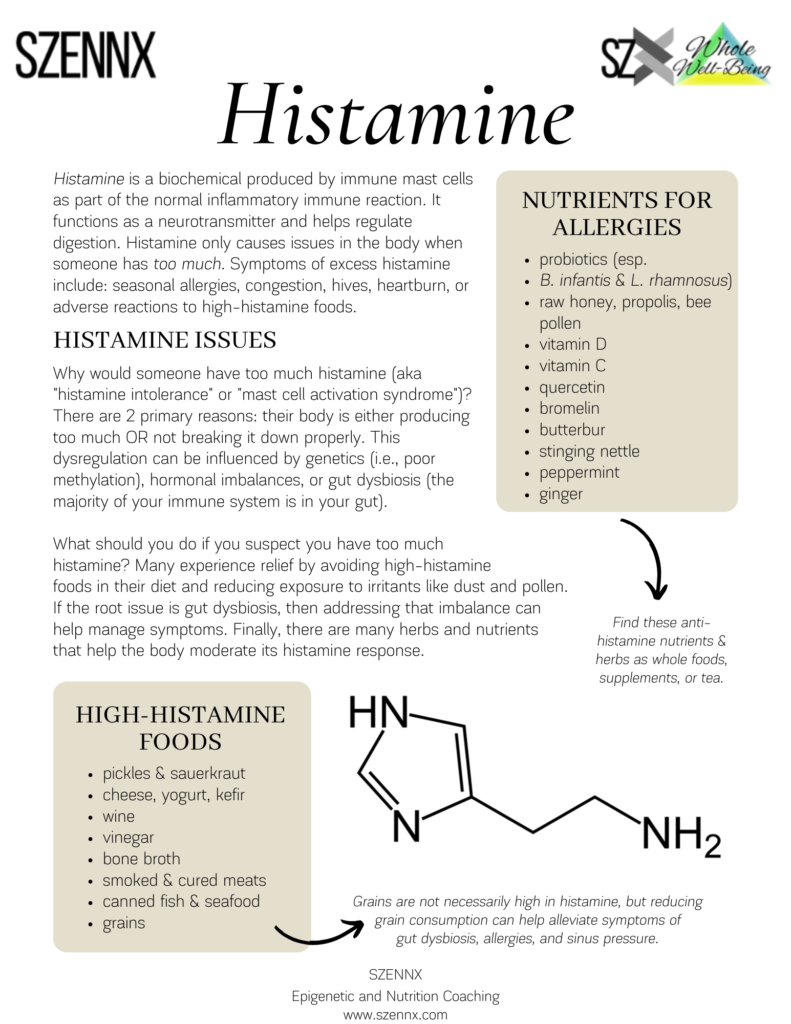
Perhaps you notice a mild rash or maybe itchiness. Watery eyes and or puffines in the face. Heartburn, bloating and/or diarrhea, all after eating foods considered healthy. If so, one of the steps is to evalauate foods to find where the trigger might be occuring. Often reactions from certain foods can be due to comprimised gut health, the gut lining being damaged allowing for toxins, pathogens, bacteria and other particles to be able to leak into the bloodstream, a term known as leaky gut. This and/or a gluten sensitivity or dairy sensitiviy or nuts causing inflammation. [1] There are times however when those foods are ruled out and still individuals have the continued reactions. Enter high histamine foods, especailly aged or fermented. These tend to get overlooked as a culprit. And unfortunately many healthy gluten-free grain-free dairy-free foods such as avocadoes, spinach, canned tuna and even certain fruits are triggers. [2]
Histamine Intolerance HIT
According to World Allergy Organization, histamine intolerance (HIT) is classified as a non-allergic food hypersensitivity [1,2] and can be defined as a disorder where reduced histamine degradation capacity in the intestines leads to the appearance of adverse symptoms possibly caused by impaired diamine oxidase (DAO) activity [1,3].
Evaluating your food intake and taking into consideration your nutrient levels is helpful in evaluating the possibility of having histamine interolerance. Something to also note, having a deficiency in certain vitamins and minerals plays a role in becoming histamine intolerant. This and certain gene markers.
Two Pathways for Histamine Metabolism
DAO/AOC1 Pathway
Let’s start with understanding the breakdown pathways for histamines. There are two pathways. The first is in the gut, where we make an enzyme called diamine oxidase or DAO. DAO metabolises much of the histamine coming from food sources along with the histamine produced by gut bacteria. This breakdown prevents a large amount of histamine from reaching the bloodstream and leading to inflammation. [2]When it comes to nutrient levels, DAO requires co-factors such as copper. Copper and zinc have an inverse relationship and thus when you’re eating a diet high in zinc or taking high zinc supplements, copper tends to be reduced. Copper being reduced then leads to a reduction of DAO activation, minimizing the ability for histamine to be broken down.
Another interesting find is that curcumin can inhibit DAO. Curcumin is touted and praised for its inflammatory properites and many take this as a supplement and/or add it to foods. This is great but when you have histamine intolerance, it can backfire, not allowing the histmine to be broken down efficiently.
Compromised gut health can also impare DAO so this is why addressing gut health first is always ideal.
Along with DAO is Amine Oxidase or AOC1, which increases the breakdwon of histamines and other bioactive amines. AOC1 requires Vitamin C, B6 and copper as co-factors. Again, nutrient levels are important and being wel-nourished with the correct balance for your own physiology is key.
HNMT & MAO-B Pathway
The second pathway consists of Histamine n-methytransferase or HNMT which breaks down histamine followed by MAO-B which breaks down the metabolite. HNMT works on the absorbed histamine and that of what is produced from gut and foods causing histamine be released, such as strawberries[4]. It metabolizes histamine using SAMe as methyl donor.
Genetics, Epigenetics and Histamine Intolerance
When looking at symptoms and considering histamine intolerance, taking the view from a genetic standpoint, we must always correlate the symptoms and consider methylation status. From a Full Comprehensive DNA Report we can get an idea of your HNMT and MTHFR Gene status.
Methylation MTHFR Gene
Here we go, gotta talk about methylation. Methylation is a chemical reaction vital for your body to repair cells, for detoxification, to optimize DNA cell function and regulate neurotransmitters and metabolizing B vitamins, namely the process of converting B9 (folate) into methyl-folate. MTHFR is an enzyme critical for the biochemical reactions that occur in your body. It is responsible for methylation. MTHFR and methylation are absolutely critical for all areas of your health, including hormonal health, mental health, behavior, and sleep.
A very important function of methylation is the conversion of homocysteine into methionine. Homocysteine is an inflammatory amino acid that is produced as a byproduct of protein metabolism (in particular methionine that is found in meats, seafood, dairy, eggs, sesame seeds and brazil nuts). The B vitamins B12, B6, B2 and magnesium and folate break down homocysteine to create other chemicals your body needs, one already mentioned methionine. Having high homocysteine levels can indicate a vitamin deficiency and low methylation status. Homocysteine can also be elevated with heavy metal exposure and enviro toxins. Methionine is important for detoxification as it produces glutathione, repairing cells as your liver breaks it down into SAMe, building protein, processing fats, and supporting your body’s healthy inflammatory response.
Under-methylation basically means there are not enough methyl molecules available to add to enzymes, hormones, and neurotransmitters. Methylation then is how we switch these important molecules ‘on’ or ‘off’ so they are active in our bodies.
Healthy mood, immune and other everyday bodily functions are the result of methylation. Having a genetic propensity to be an undermethylator gives a higher risk for inflammation throughout the body due to high histamine and thus the histamine being leaked into the bloodstream. Histamines also have the ability to cause a decrease in neurotransmitters. Genetics can contribute, but more often it is a consequence of our choices around lifestyle and what we eat. Epigenetics! A focus on decreasing histamine exposure can assist in minimizing the symptoms. Take a break from the red wine and cheese.
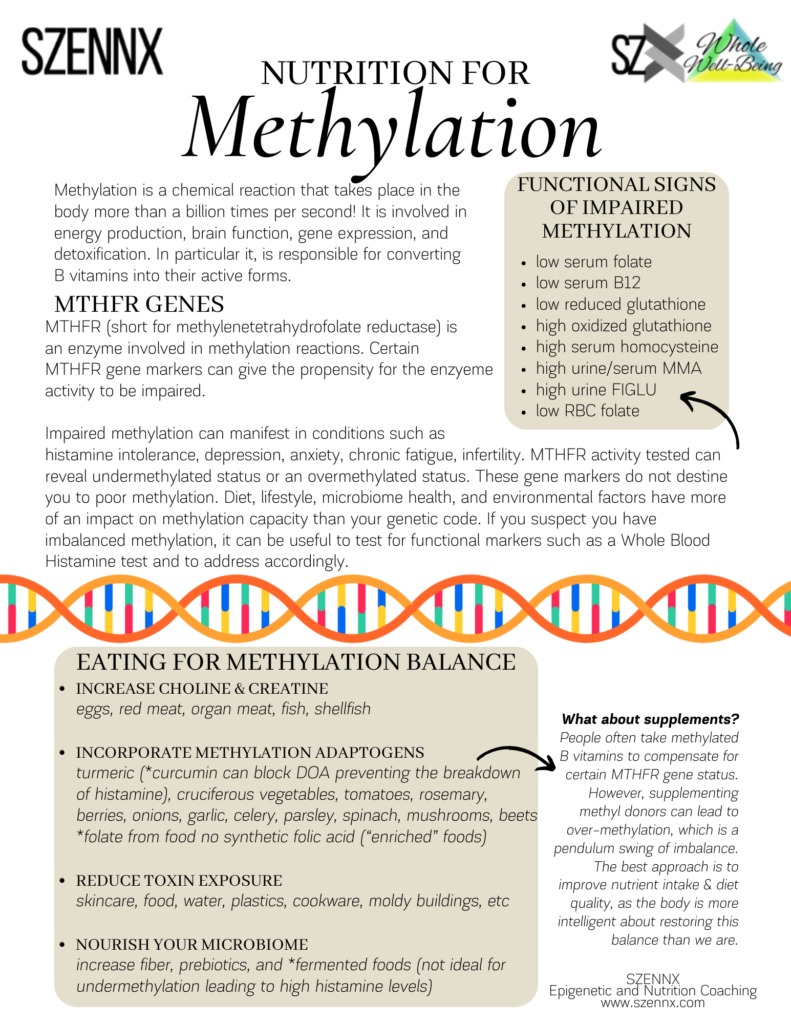
Methylation status and histamine levels typically have an inverse relationship. Recall from earlier in this post, HNMT requires SAMe as a cofactor. HNMT works on the absorbed histamine, metabolizing it using SAMe as methyl donor. Undermethylation leads to lower SAMe, therefore the SAMe needed is not available and histamine is increased.
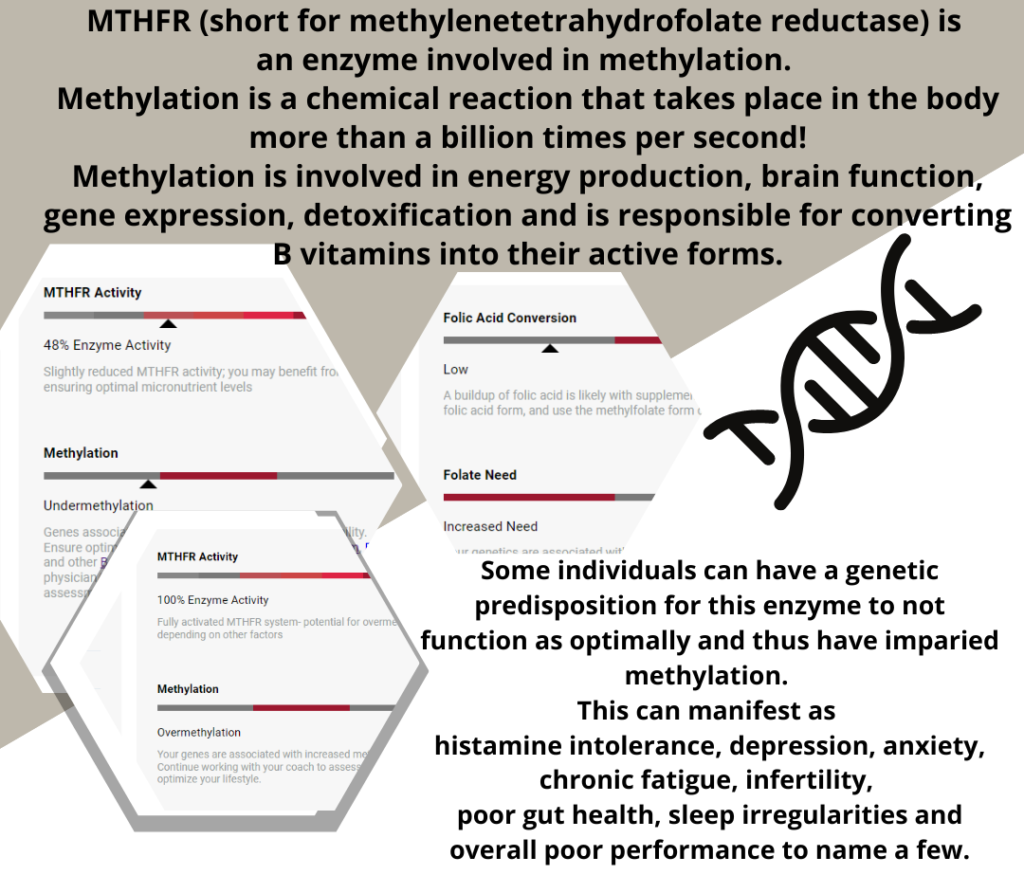
WHOLE BLOOD HISTAMINE
Ok, now beyond the adverse symptoms and the genetic test of possibly being an undermethylator, how would one know if they do have high histamine? A whole blood histamine test has been useful in clinical practice however it is not an approved diagnostic test.
Ranges are generaly
<40 ng/ml histamine level = histepania and typically correlated to overmethylation
>70 ng/ml histamine = histadelia and typically undermethylation
40-70ng/ml = normal
START TODAY
If you have the propensity of having histamine intolerance, there are natural solutions to take to begin your path of being Well-Nourished, Well-Fed, Well-Satisfied, Well-Hydrated, Well-Rested and Well-Fit. All for Your Whole Well-Being. Go to SZENNX to get started on having your Full Comprehensive DNA Report. Once you work with me as your Epigenetic Coach, the MTHFR and HMNT gene status will be noted as well as the body’s ability to methylate and convert B vitamins and breakdown histamine will be considered into your daily eating routine.
Well-Nourished. To begin, the first step of being Well-Nourished is to remove the inflammatory foods, the T.R.A.S.H. foods which is the very first step in my Six Steps to Wellness. Transformed Refined Artificial Soy Hydrogenized, which breaks down to include the transformed foods being GMO, processed food, canned and processed meat, aiming for real whole foods. Refined sugar, refined oils, refined fours and salt. Artificial ingredients and also limiting alcohol. Soy and soda and then hydrogenized oils which are seed oils. Go for extra virgin olive oil and avocado oil and macadamia nut oil. The next step would be to avoid high-histamine foods, such as fermented foods like sauerkraut, kimchi, fermented vegetables, kombucha which usually are good to introduce good bacteria in the gut, when having histamine imbalance it is ideal to minimize. Aged cheese, processed meat, canned fish, plus over-ripe fruits and vegetables included. Foods that are naturally high in histamine include avocadoes, eggplant, spinach, dried fruits and not to mention the foods that may trigger histamine releases, such as tomatoes, most citrus, bananas, most nuts, and dairy. Foods that may block the DAO enzyme, include curcumin, black tea, green tea, alcohol, and certain energy drinks.
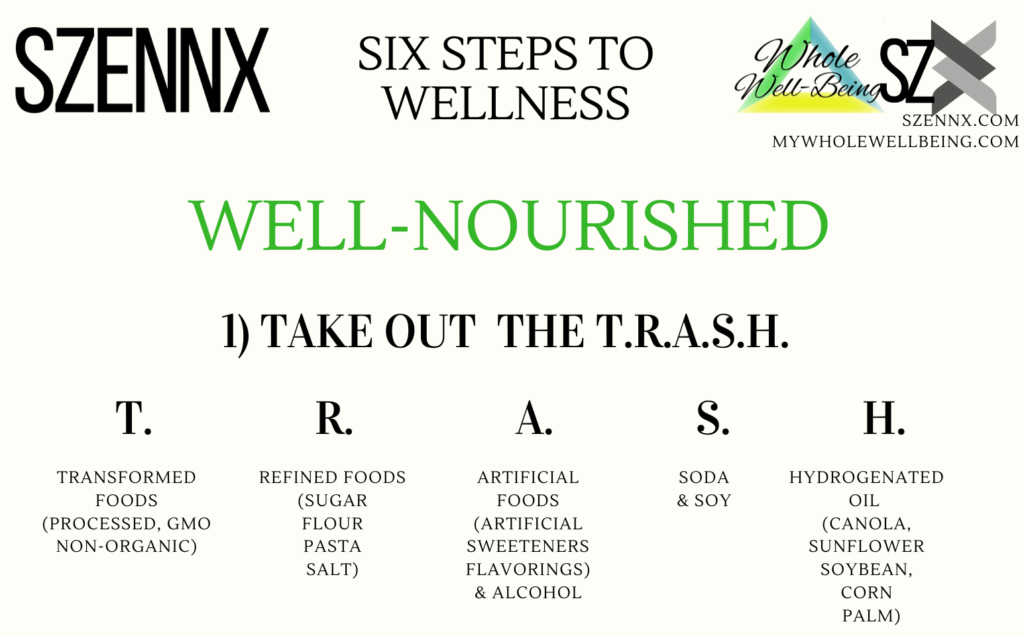
When it comes to supplements, my clients and those who know me are aware I am not big on taking any supplements. I like nutrients to come naturally from your food intake. So this goes without saying, it is best to consume natural folate, not folic acid which is the inactive synthetic man-made form of B9 and it competes with the active B9. Our body must convert it where undermethylators have a tendancy to not convert this well and a build-up occurs. Quatrefolic Acid or L-5-MTHF is the active form. Foods such as leafy greens, beef liver, broccoli, asparagus. Take note of your supplements, whether it be single-ingredient or multi, look at the B vitamins listed and make sure they are pre-methylated forms.
Well-Nourished and Well-Fed is supporting gut health. I always start clients on a gluten-free phase to help the gut lining repair itself. This isn’t forever but it is ideal to allow for healing. The SZENNX Full Comprehensive DNA Report does provide gene markers for gluten sensitivity along with grain, dairy, caffeine and insulin resistance.
Well-Zen, Well-Enjoyed and Well-Defined. Obviously we have stress, and good stress or eustress is helpful. It is chronic stress that can increase mast cell activation, allowing for histamine intolerance and histamine-related symptoms. Know who you are, be grounded and define your own life’s actions! Breathwork, meditation, positive affirmation, journaling, yoga, grounding, and time in nature for stress and anxiety reduction.
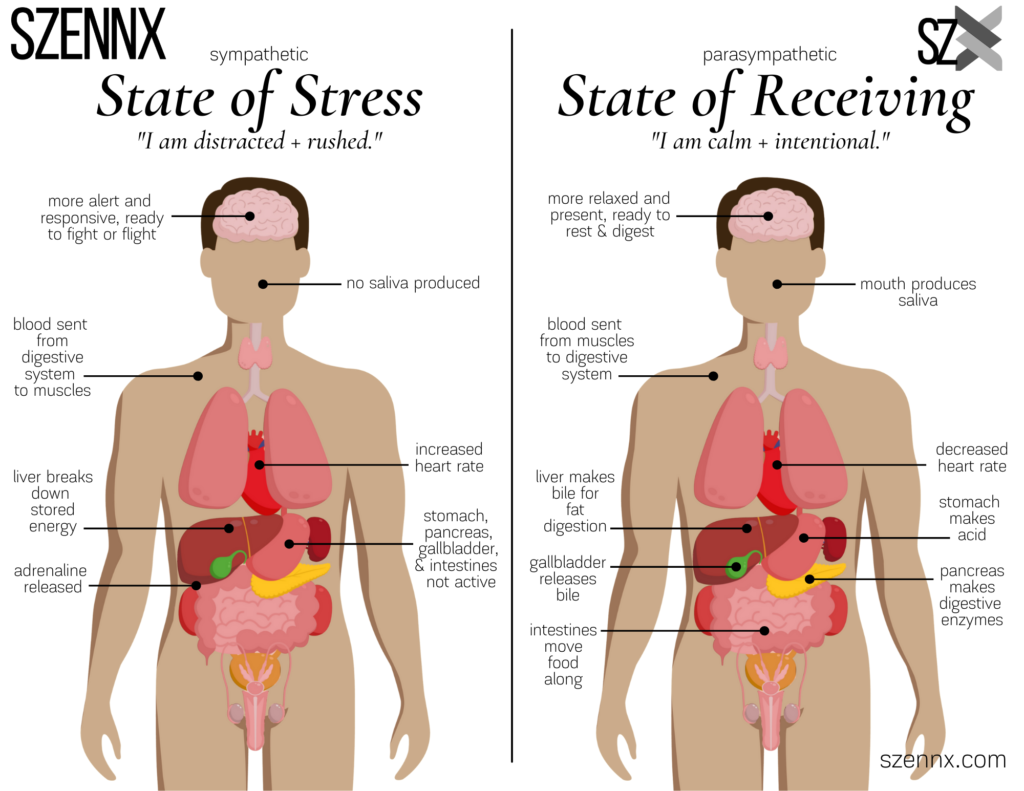

Well-Rested. This is also in my six steps to Wellness. Inadequate and poor sleep may rigger histamine and histamine-related issues. Improving your sleep is absolutely essential for your health. SZENNX Full Comprehensive Reportdoes offer your genetic predisposition of your ideal sleep cycle, circadian rhythm, wake and sleep times and sleep duration. All from your ancestry lineage!
This post is for educational purposes only and is not to be taken as medical advice or therapy. Information on this website are not intended to diagnose, treat, cure or prevent any disease. Please speak with an appropriate healthcare professional when evaluating any wellness related therapy.
References
- https://www.ncbi.nlm.nih.gov/pmc/articles/PMC6682924/
- https://www.ncbi.nlm.nih.gov/pmc/articles/PMC10346277/
- https://www.ncbi.nlm.nih.gov/pmc/articles/PMC8069563/#:~:text=Histamine%20intolerance%20(HIT)%20is%20assumed,properly%20within%20the%20GI%20tract.
- https://www.ncbi.nlm.nih.gov/pmc/articles/PMC8469513
-
MTHR Methylation and histimin in psychiatric conditions
